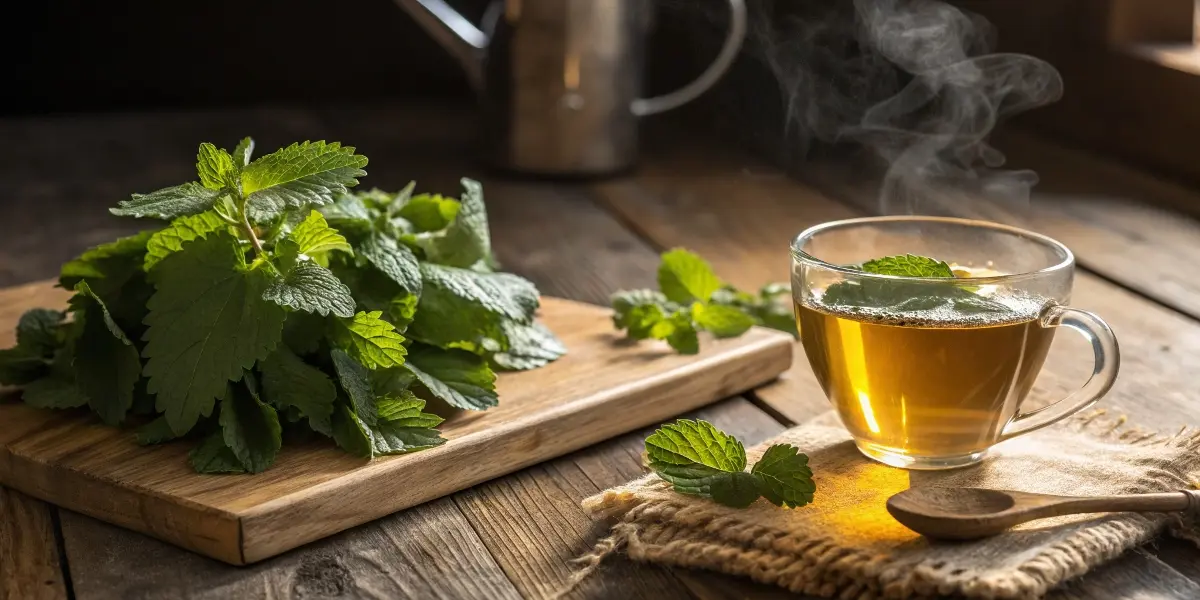From the moment I first washed lemon balm in my childhood kitchen, its bright, citrusy fragrance stirred something calming. Crushing the leaves between my fingers released that familiar aroma—and later brewing them into tea became a ritual I cherish. This lemon balm tea recipe brings warmth with gentle wellness benefits, without sacrificing flavor. You’ll learn how to make lemon balm tea exactly right, uncover what it does for your mind and digestion, understand what to avoid mixing it with, find ideas for sourcing the herb, and explore thoughtful uses—all built around honest, approachable guidance.
New to keto? Start with our Keto Diet for Beginners: Simple American Guide to Start Today for the full basics, then come back to these recipes.
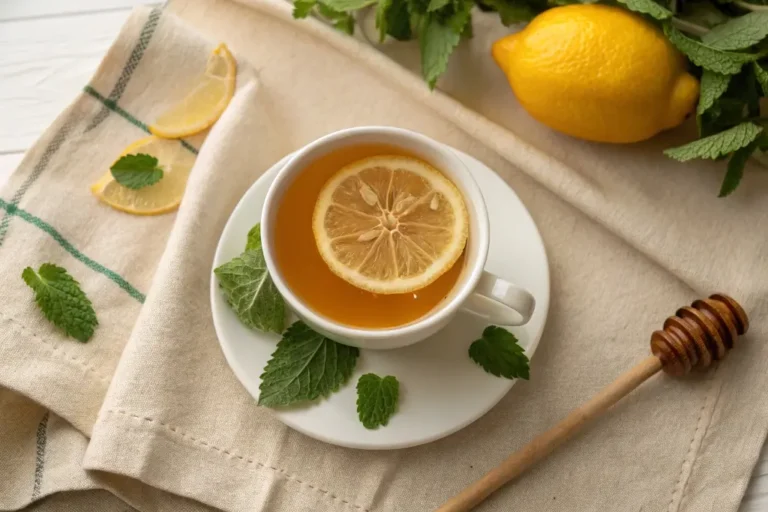
Lemon Balm Tea Recipe for Relaxation and Gut Health
A calming herbal infusion made with fresh or dried lemon balm leaves, ideal for stress relief, digestion, and gentle hydration.
- Total Time: 12
- Yield: 1 cup
Ingredients
1 cup fresh lemon balm leaves (or 1 tbsp dried)
1 cup boiling water
Optional: 1 tsp honey, 1 lemon slice, 1 mint sprig
Instructions
1. Rinse lemon balm leaves and gently crush to release oils.
2. Place leaves in a teapot, infuser, or heatproof mug.
3. Boil water to approx. 200°F and pour over the leaves.
4. Cover and steep for 7–10 minutes (fresh) or up to 15 (dried).
5. Strain the tea and serve warm or iced.
6. Optional: Add honey, lemon, or mint for flavor.
Notes
Use fresh lemon balm for brighter aroma.
Store dried leaves in airtight container away from sunlight.
Drink up to 2 cups daily for wellness benefits.
- Prep Time: 2
- Cook Time: 10
- Category: Drinks
- Method: Steeping
- Cuisine: Herbal
Table of Contents
How to Make Lemon Balm Tea Recipe
Preparing the Lemon Balm Leaves
Choose fresh leaves when possible—for each cup of tea, use about 1 cup of fresh leaves or 1 heaping tablespoon of dried. Rinse them gently, then crush or rub between your fingers. This simple step awakens the essential oils and brightens both aroma and taste. Crushed dried leaves work well too, though their flavor may be slightly milder.
Brewing Your Tea
Heat fresh water to just under a vigorous boil—aim for about 200 °F (93 °C). Place the crushed leaves into a teapot, infuser, or sturdy mug. Pour the hot water over them, stir gently to distribute, and cover the vessel. Let the tea steep for 7 to 10 minutes when using fresh leaves; extend steeping to 12–15 minutes with dried leaves for a richer infusion. When it’s ready, strain into your cup carefully.
Serving Styles and Flavor Enhancements
Enjoy plain or customize with a drizzle of honey, a thin lemon slice, or a sprig of fresh mint. For a summer twist, chill the brewed tea, pour it over ice, and garnish with lemon balm leaves and citrus wedges. That ice-cold version becomes a soothing, refreshing herbal beverage. For fans of balanced meals or creative pairings, check out our pieces around herbal beverages and nourishing sides, including bariatric tea for gentle digestion and our high‑protein quiche or high‑protein pureed food recipes.
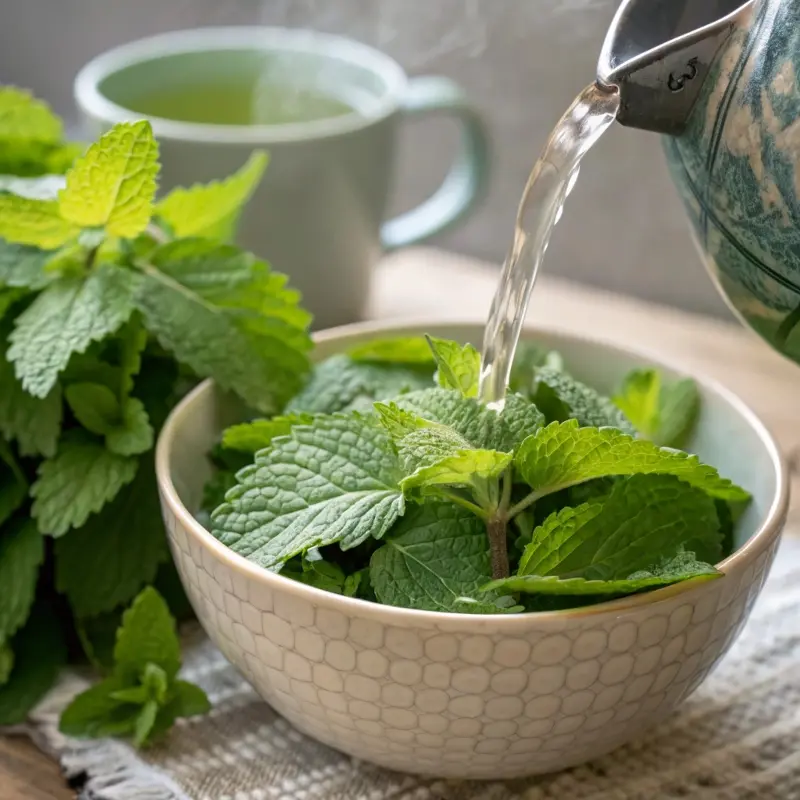
Quick Tips Table
| Step | Details |
|---|---|
| Leaf amount | 1 cup fresh or 1 tbsp dried per 8 oz water |
| Water temp | About 200 °F |
| Steeping time | 7–10 min (fresh), 12–15 min (dried) |
| Add-ins | Honey, lemon, mint, lavender blend |
What Does Lemon Balm Tea Do for You?
Promotes Relaxation and Reduces Stress
Drinking lemon balm tea helps calm the mind. Many enjoy it before bedtime or during anxious moments—its mild, fragrant qualities help soothe tension and quiet a busy brain. A cup often becomes a small ritual of peace. If you’re building a wellness routine, starting or ending your day with this tea can anchor a sense of calm.
Supports Digestion and Eases Bloating
Lemon balm tea can gently stimulate digestion. Drinking it after meals may ease mild bloating or stomach discomfort. Since it contains no caffeine, it supports relaxation without interfering with sleep cycles or hydration. Blending lemon balm tea with herbal options like peppermint or chamomile deepens the digestive support—explore more in our bariatric tea article for similar herbal beverage ideas.
Boosts Mood and Mental Focus
Regular but moderate use helps many feel mentally clearer and more centered. Some people share that a cup mid-afternoon boosts mood and mental balance without overstimulation—perfect when you need to steady your focus. With its subtle citrus herbal aroma, lemon balm tea becomes a gentle companion through moments that demand calm energy.
Calming Companion in Balanced Living
Pair lemon balm tea with nutrient-packed diets or mindful eating plans. For plant-based or protein-rich combinations, consider our vegan mushroom recipes or high‑protein chicken feed as satisfying meal complements. These foods support the wellness approach that lemon balm tea fits into—nourishment without compromise.
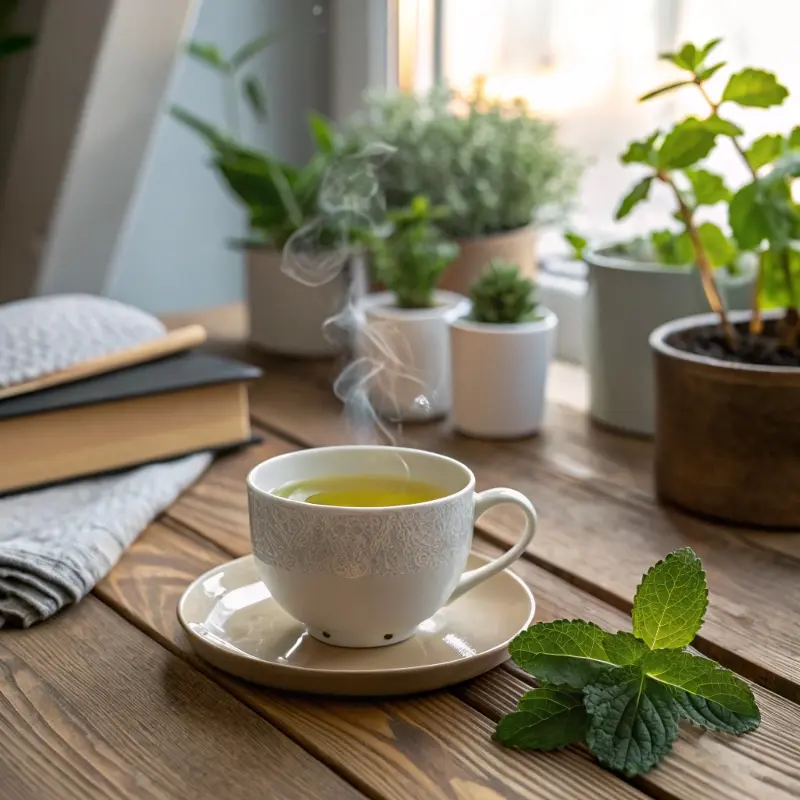
What Not to Mix with Lemon Balm Tea & Safety Tips
Possible Drug Interactions
If you take sedatives, thyroid medications, or anti-anxiety drugs, combining them with lemon balm tea may increase drowsiness. It’s safest to check with your healthcare provider before adding lemon balm tea to your routine, especially if you’re on central nervous system depressants or hormone-based treatments.
Populations to Use with Caution
Pregnant or breastfeeding individuals should use lemon balm tea only under guidance, as research on long‑term herbal intake during this period remains limited. Children and older adults may also need lower amounts to avoid potential dizziness or sluggishness from excessive use. It’s best to start small and observe how your body responds.
Avoiding Overconsumption and Allergic Reactions
Though gentle, drinking lemon balm tea daily for many months isn’t well studied. Stick to moderate use. If you have known allergies to mint-family plants, lemon balm may trigger mild reactions like rash or stomach upset. Always test a small serving first. If discomfort occurs, discontinue use and consult your healthcare provider.
Safe Guidelines Table
| Consideration | Best Practice |
|---|---|
| Interactions | Avoid mixing with sedatives or thyroid meds |
| Sensitive Groups | Use smaller amounts if pregnant, elderly, or child |
| Allergies | Avoid if sensitive to mint-family plants |
| Overuse | Enjoy in moderation—not daily for months without breaks |
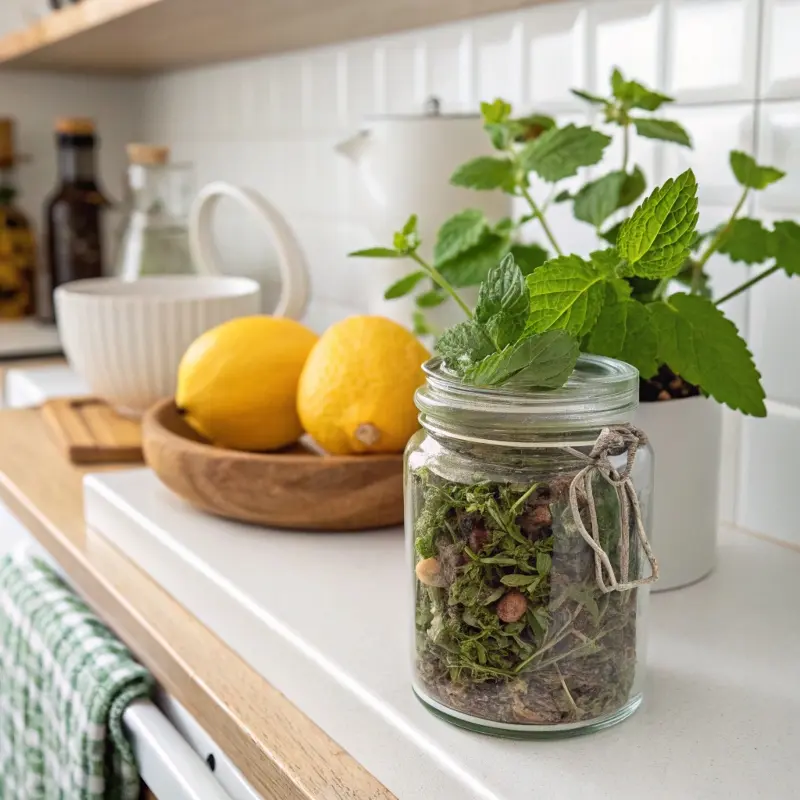
How to Get Lemon Balm & Final Tips
Growing or Buying Lemon Balm
You can grow lemon balm in your garden or a sunny windowsill. Harvest leaves early in the morning, rinse them gently, and use fresh or dry them by hanging bundles indoors or laying them on a rack at low temperature. If you prefer buying, look for dried leaves at your local herb shop or online natural retailers.
Storing Lemon Balm Properly
Keep dried leaves in an airtight container, placed away from direct sunlight and heat. This preserves their fragrance and potency for months. Fresh leaves work best when used within a few days—store them loosely wrapped in the fridge and use them promptly.
Blending Ideas and Flavor Twists
Enhance flavor by blending lemon balm with other herbs like mint, lavender, or a touch of ginger. Try infusing a slice of lemon or a piece of fresh ginger root during steeping for extra zing and metabolism-friendly support. Pair with a light meal or snack such as those featured in our high‑protein quiche or pink salt weight loss recipe for a fuller wellness upgrade.
When to Drink It for Best Effect
Start your day with a cup to promote calm focus. A mid-day cup may ease meal-related discomfort or support digestion. An evening cup helps transition into rest with a sense of ease. It works best within a balanced routine—tea as a small anchor in your day rather than a cure-all focus.
FAQs about Lemon balm tea recipe
How do you make lemon balm tea?
Use 1 cup of fresh leaves or 1 tablespoon of dried leaves per cup of boiling water. Crush the leaves gently, steep for 7–10 minutes (fresh) or up to 15 (dried), strain, and optionally sweeten with honey or lemon slice.
What not to mix with lemon balm tea?
Avoid combining lemon balm tea with sedatives, thyroid medications, or other central nervous system depressants, as it may amplify drowsiness or affect breathing. Pregnant or nursing individuals, children, and older adults should use caution.
What does lemon balm tea do for you?
It promotes relaxation, reduces mild anxiety, supports digestion, eases bloating, and may enhance mental clarity with moderate, regular use.
How do you get lemon balm tea?
Grow fresh lemon balm at home or buy dried leaves from herb shops or online. Harvest morning leaves for peak aroma. Dry them indoors or use low‑heat drying methods. Store in airtight containers away from light.
Conclusion
This lemon balm tea recipe brings a simple herbal ritual into your daily wellness routine—balancing flavor, aroma, and gentle support for mind and body. Whether you brew it fresh, chill it over ice, or blend it with complementary ingredients, lemon balm tea stands out for its calming effect and digestible nature. Use it thoughtfully—avoid combinations with sedatives or certain medications, keep doses moderate, and savor it as part of a balanced lifestyle. It’s wellness in a cup, steeped in tradition and tailored to healthful living.
A recent study published in BMC Complementary Medicine and Therapies confirms the beneficial effects of lemon balm on cardiovascular health.

